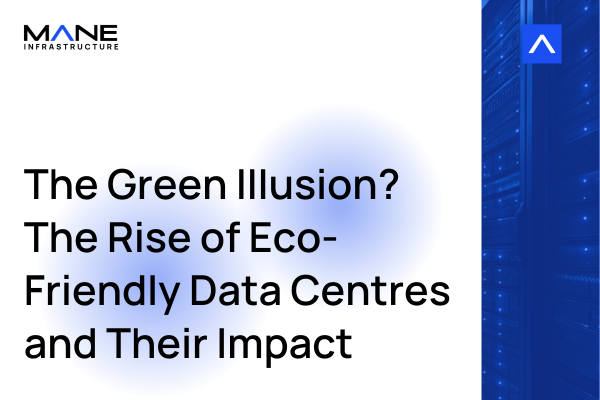The Green Illusion? The Rise of Eco-Friendly Data Centres and Their Impact
17 Apr, 20254 minsData centres have become the invisible backbone of our digital world, powering everything fr...

Data centres have become the invisible backbone of our digital world, powering everything from cloud storage to artificial intelligence. With Portugal set to attract over €12 billion in data centre investments and similar growth worldwide, these digital warehouses are rapidly expanding their footprint on our planet. But as concerns about their environmental impact grow, a pressing question emerges: can data centres ever truly be green?
The Colossal Digital Footprint
Modern data centres are enormous consumers of resources. They currently account for approximately 1-3% of global electricity consumption—a figure that could reach one-third of the planet's energy use by 2025 according to Huawei predictions, driven by the explosive growth of AI technology.
The environmental cost is substantial:
- Carbon emissions: Global data centres produce between 2-4% of the world's carbon footprint
- Water consumption: A staggering 3.8 litres of fresh water is needed for every kilowatt-hour of electricity used
- Land usage: Data centres require vast tracts of land, with the annual global land footprint of data storage estimated at over 110 square kilometres
Google alone used 21.5 billion litres of water in 2021 - a figure that increased by 20% to 5.6 billion gallons in 2022, with AI cited as the main reason for this surge. According to Gartner, even a relatively simple task like processing 20-50 ChatGPT queries requires half a litre of water.
The Dark Data Dilemma
Perhaps the most troubling aspect of data centres' environmental impact is the amount of resources wasted on "dark data" - information that is collected, stored, but never used again.
Research indicates that:
- 54% of worldwide data storage is classified as dark data
- Less than 1% of this dark data is ever accessed again
- Annual global carbon emissions from storing dark data may approach 5.26 million tonnes
- Water and land footprints associated with dark data storage are estimated at 41.65 gigalitres and 59.45 square kilometres, respectively
As data storage continues to grow at approximately 27% annually, this problem is set to worsen dramatically, with Statista projecting that the number of IoT devices will nearly double to 29.42 billion by 2030.
The Green Data Centre Movement
In response to these environmental challenges, the concept of "green data centres" has emerged. These facilities aim to minimise their ecological footprint through innovations in design, operation, and energy sourcing.
Key characteristics of green data centres include:
- Strategic location: Positioning facilities in cooler climates can reduce cooling requirements, with research showing this can cut greenhouse gas emissions by 8%
- Renewable energy: Using wind, solar, or hydroelectric power sources
- Advanced cooling systems: Implementing air cooling or direct-to-chip liquid immersion cooling to reduce water consumption
- Energy efficiency: Optimising Power Usage Effectiveness (PUE), with the industry aiming for ratios of 1.2 or lower
- Server utilisation: Addressing the problem of "zombie servers" - machines that consume power but don't perform computing tasks
- Circular economy principles: Extending infrastructure lifecycles and implementing comprehensive recycling programmes
Leading the Green Revolution
Several tech giants are pioneering sustainable approaches to data centre operations:
Google tops many sustainability rankings, having been carbon-neutral since 2007. Their Finnish data centre recycles 100% of electronics before replacement and uses seawater cooling to reduce freshwater usage.
Digital Realty became the first data centre worldwide to achieve one gigawatt of IT capacity powered entirely by zero-emission sources and has reached 100% renewable energy coverage across its US and European portfolios.
Schneider Electric, crowned the most sustainable company in the world in 2021, has made significant contributions through its EcoStruxure Smart Grid, which was instrumental in Italy's achievement of 40% renewable energy coverage.
Apple's North Carolina data centre uses multiple renewable energy sources and advanced cooling systems that allow their built-in chillers to remain off 75% of the time.
Controversy and Criticism
Despite these advances, critics argue that truly green data centres remain more aspiration than reality. Several controversial aspects persist:
Greenwashing concerns: Some environmental claims may mask the true impact of these facilities, with companies highlighting renewable energy use while downplaying water consumption or land usage.
Geographic displacement: While data centres in Scandinavia can leverage natural cooling, facilities in water-stressed regions face much greater sustainability challenges. Critics argue that simply shifting environmental burdens geographically doesn't solve the fundamental problem.
Energy attribution certificates: Many data centres claim to use renewable energy through certificates rather than direct consumption, raising questions about their actual environmental impact.
AI's growing thirst: The rapid expansion of AI applications threatens to negate efficiency gains, with Google citing AI as the primary reason for its significant increase in water consumption.
Resource competition: In regions experiencing water scarcity, data centres often compete with local communities and agriculture for precious resources. This has triggered public outcry in drought-prone areas like California and Arizona.
The Path Forward
Addressing the environmental challenges of data centres requires a multi-faceted approach:
Data minimisation: The most sustainable solution may be to simply delete unnecessary data, particularly dark data that serves no purpose but consumes significant resources.
Tape storage adoption: Research suggests that migrating 57% of archived data to tape storage could reduce CO2 emissions by 43.7% by 2030, potentially avoiding 664 million tonnes of emissions.
Regulatory frameworks: Government incentives and regulations will be instrumental in driving the development of genuinely green data centres. The EU Climate Neutral Data Centre Pact, which commits signatories to carbon neutrality by 2030, represents a step in this direction.
Community integration: Data centres can add value to local communities by offering surplus heat for district heating systems, partnering with businesses to create integrated industrial clusters, and providing long-term employment opportunities.
Transparency and reporting: Enhanced environmental reporting, as required by emerging regulations like the EU Energy Efficiency Directive and Corporate Sustainability Reporting Directive, will help drive continuous improvement.
The Verdict
While significant progress has been made toward reducing the environmental impact of data centres, the explosive growth of digital technologies—particularly AI—threatens to outpace these improvements. The concept of truly green data centres remains challenging to achieve, especially as global data demands continue to surge.
The industry stands at a crossroads: it can either embrace fundamental changes in how data is valued, stored, and managed, or it can continue on a path that may prove unsustainable as resource constraints intensify. The future of green data centres will likely depend on a combination of technological innovation, regulatory pressure, and corporate commitment to genuine sustainability rather than superficial greenwashing.
As we navigate this digital future, one thing becomes clear: our seemingly ethereal "cloud" has very real and significant earthly impacts. The question is no longer whether we need sustainable data centres, but how quickly we can transform our digital infrastructure to align with the planet's ecological boundaries.



